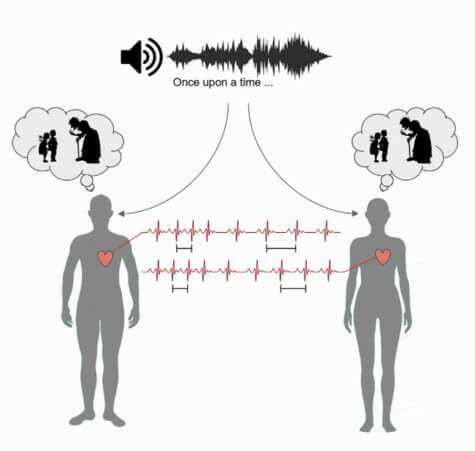PARIS, France — People subconsciously synchronize their heart rates while listening to stories together, a new study reveals. Just as lovers’ hearts beat at the same pace when they share a passionate moment or when fans marvel at a live performance by their favorite band, people often synchronize physiology when participating in activities together. Now a groundbreaking study by an international team of scientists finds that heart rates line up with each other as people pay close attention to hearing the same story.
“There’s a lot of literature demonstrating that people synchronize their physiology with each other. But the premise is that somehow you’re interacting and physically present in the same place. What we have found is that the phenomenon is much broader, and that simply following a story and processing stimulus will cause similar fluctuations in people’s heart rates. It’s the cognitive function that drives your heart rate up or down,” says study co-author Professor Lucas Parra of the City College of New York in a media release.

“What’s important is that the listener is paying attention to the actions in the story,” adds co-senior author Dr. Jacobo Sitt of the French National Institute of Health and Medical Research. “It’s not about emotions, but about being engaged and attentive and thinking about what will happen next. Your heart responds to those signals from the brain.”
Paying attention is key
The investigators conducted a series of four experiments to explore the role of consciousness and attention in synchronizing participants’ heart rates. In the first one, healthy volunteers listened to an audiobook of Jules Verne’s “20,000 Leagues Under the Sea.” As they listened, their heart rate changed based on what was happening in the story. The team recorded similar fluctuations using an electrocardiogram. As a result, the researchers found that the majority of participants showed increases and decreases in their heart rate at the same points in the narrative.
In the second experiment, volunteers watched short educational videos with no underlying emotional variations. Study authors concluded that the presence of emotional engagement was integral to heartbeat synchronization. The participants then watched the videos a second time while counting backwards in their heads. As they did so, the lack of attention resulted in a drop in the synchronization of heart rates across the group, confirming that attention is important to the phenomenon.
In the third experiment, volunteers listened to short children’s stories. While the team left some of the volunteers to concentrate, researchers distracted some participants at the end of the stories. All of the participants then had to recall facts from the stories. Researchers found that the more synchronized each person’s heartbeat was with their peers, they scored better on the memory tests. This indicated that the changes in the heart rates signal a conscious processing of the narrative. Even though breathing can affect heart rates, researchers did not see the same synchronization among the subjects.
Do stories having healing powers?
The fourth and final experiment included a sample of both healthy volunteers and patients suffering from disorders of consciousness, including those in comas and persistently vegetative states. Study authors presented each person with an audiobook of a children’s story and, as expected, the patients measured lower rates of heart synchronization than the healthy volunteers. However, to the surprise of the researchers, when the team examined these participants six months later, a portion of those with higher synchronization had regained some levels of consciousness.
“This study is still very preliminary, but you can imagine this being an easy test that could be implemented to measure brain function. It doesn’t require a lot of equipment. It even could be performed in an ambulance on the way to the hospital,” says Dr. Sitt.
He confirmed that scientists will need to conduct further research using larger study groups to validate and make comparisons with existing brain function tests like electroencephalograms (EEGs) and functional magnetic resonance imaging (fMRI). Prof. Parra adds such research is important for understanding how mindfulness affects the brain-body connection.
“Neuroscience is opening up in terms of thinking of the brain as part of an actual anatomical, physical body. This research is a step in the direction of looking at the brain-body connection more broadly, in terms of how the brain affects the body,” Parra concludes.
The study was published in the journal Cell Reports.
South West News Service writer Georgia Lambert contributed to this report.
